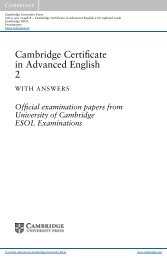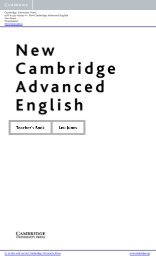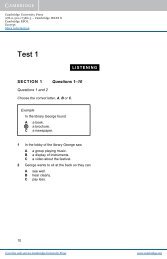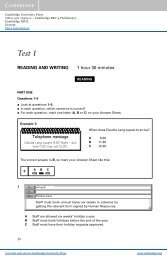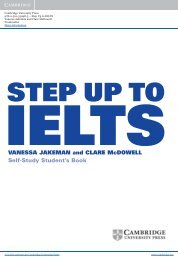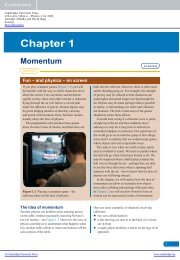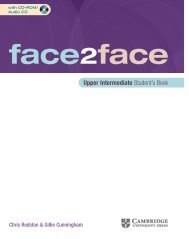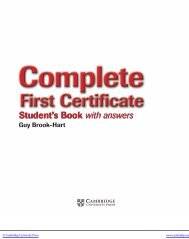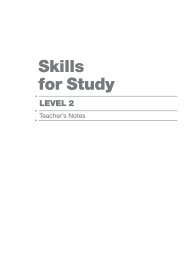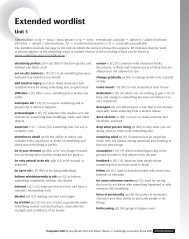Second edition - Cambridge University Press
Second edition - Cambridge University Press
Second edition - Cambridge University Press
You also want an ePaper? Increase the reach of your titles
YUMPU automatically turns print PDFs into web optimized ePapers that Google loves.
CriticalThinkingAn Introduction<strong>Second</strong> <strong>edition</strong>Alec Fisher
CAMBRIDGE UNIVERSITY PRESS<strong>Cambridge</strong>, New York, Melbourne, Madrid, Cape Town,Singapore, São Paulo, Delhi, Tokyo, Mexico City<strong>Cambridge</strong> <strong>University</strong> <strong>Press</strong>The Edinburgh Building, <strong>Cambridge</strong> CB2 8RU, UKwww.cambridge.orgInformation on this title: www.cambridge.org/9781107401983© <strong>Cambridge</strong> <strong>University</strong> <strong>Press</strong> 2011This publication is in copyright. Subject to statutory exceptionand to the provisions of relevant collective licensing agreements,no reproduction of any part may take place without the writtenpermission of <strong>Cambridge</strong> <strong>University</strong> <strong>Press</strong>.First published 2001<strong>Second</strong> <strong>edition</strong> 2011Printed in the United Kingdom at the <strong>University</strong> <strong>Press</strong>, <strong>Cambridge</strong>A catalogue record for this publication is available from the British LibraryISBN 978-1-107-40198-3 Paperback<strong>Cambridge</strong> <strong>University</strong> <strong>Press</strong> has no responsibility for the persistence oraccuracy of URLs for external or third-party internet websites referred to inthis publication, and does not guarantee that any content on such websites is,or will remain, accurate or appropriate.
ContentsPrefacev1 Critical thinking: what it is and how it can be improved 12 Identifying reasons and conclusions: the language ofreasoning 163 Understanding reasoning: different patterns of reasoning 354 Understanding reasoning: assumptions, context and athinking map 505 Clarifying and interpreting expressions and ideas 646 The acceptability of reasons, including their credibility 837 Judging the credibility of sources skilfully 988 Evaluating inferences: deductive validity and other grounds 1149 Evaluating inferences: assumptions and other relevantarguments 13310 Reasoning about causal explanations 14911 Decision-making: options, consequences, values and risks 16712 How to get reliable information from the internet (Criticalthinking about the internet) 184Questions appendix 212Answers to questions 239Glossary 276Bibliography 285Index 287Acknowledgements 293
Dedicated to my grandchildrenLeonora, May, Eliza and Barnaby
PrefaceThis book aims to teach critical thinking skills: the ability to interpret,analyse and evaluate ideas and arguments. It is based on a widelyshared conception of critical thinking and it covers many of the basicskills or competencies displayed by good critical thinkers. It aims todevelop those skills by teaching them explicitly and directly, rather thanindirectly as many teachers claim to do in the course of teaching theirsubject – history, physics or whatever. It also aims to teach these skillsso that they can be transferred to other studies and to everyday life.Critical thinking is now widely seen as a basic competency, akin toreading and writing, which needs to be taught. That is what this bookaims to do.After an initial chapter which explains what critical thinking isand how to teach it, the early chapters focus on analysing reasoning.However, students usually want to move on to the task of evaluatingarguments and presenting their own! Since students enjoy the processof arguing, I usually encourage them to do this from the very beginning,and I also get them to note their responses. Later, as they learn moreabout evaluating and presenting arguments, they can look back atwhat they did earlier and see how much better they can do it. In thisconnection I have often required students to keep a ‘critical thinkingnotebook’ in which they answer questions as they are set, to help themevaluate their progress. To make this self-evaluation students need tocompare their answers with those provided at the back of this book andhave their work graded and the grading explained to them. This helpsthem internalise what they are learning.Studying critical thinking involves trying to change the ways inwhich most of us think. To do this we need extensive practice andfeedback. That is why the book has many stimulus passages on subjectsof topical interest and over 220 questions for the student to answer.
vi PrefaceAnswers are provided to more than three-quarters of these to helpstudents check their progress. The ‘thinking maps’ are sets of questionsstudents should ask themselves when trying to think skilfully invarious ways. Of course, critical thinkers not only exhibit the skills wehave mentioned, but also value reasonableness. It is to be hoped thatworking through this material will also encourage what Socrates calledthe ‘examined life’.The book is suitable for a wide range of students. It is used extensivelyin North American schools and colleges, in the UK for the CriticalThinking examinations produced by OCR (Oxford, <strong>Cambridge</strong> and RSAExaminations) and AQA (Assessment and Qualifications Alliance),for the International Baccalaureate and in many other contexts andcountries. Many of the ideas and examples arose in the course of myteaching critical thinking to young people and adults in North and SouthAmerica, Europe, Africa and the Far East. The material is presentedin such a way that it can be worked through on a self-study basis,but those who do this should try to discuss their ideas and argumentswith other people. This usually turns out to be instructive and fun forboth parties!Teachers who use this book for their students may find the followingsuggestions helpful. Although some things need to be explained by theteacher, I find that discussion in small groups can be very successful(four per group is a good number). Students love arguing with eachother and, given good examples (stimulus passages), this can beboth enjoyable and instructive. Applying thinking maps to your ownthinking can be difficult at first so it can be useful to put students inpairs for this purpose – one doing the exercise whilst the other helpsthem focus on answering the questions in the thinking map. There areseveral good sources for finding further stimulus material of interestto students: look in any ‘quality’ newspaper at the letters to the editor,the editorials or ‘analysis’ articles. It can also be very helpful to draw onmaterials which students are encountering in other courses.This second <strong>edition</strong> differs from the first in two main ways. Numeroussmall improvements have been made throughout the text, but the twolarge changes are (i) there is a new chapter about the internet and howto find reliable information there (chapter 12), and (ii) more than twothirdsof the examples and passages in the Questions appendix havebeen replaced by completely new material, with consequent changes inthe body of the text and in the Answers section.
Preface viiThese days, people use the internet so much to find information –and so much of what is presented there is unreliable – that if you wantto be a good critical thinker you need to know how to use the interneteffectively, and that is what I have explained in chapter 12. There aremany places earlier in the book where I suggest that the reader couldresearch something on the internet, and the internet chapter containsexercises which mostly refer to issues discussed earlier in the book.Some readers might like to read chapter 12 early to help them work onexercises which occur in earlier chapters; others may prefer to read thechapters in the order presented.Many of the passages in the Questions appendix are used for quitespecific purposes in exercises in the book, but once the reader hasbecome familiar with and practised the techniques described, most ofthe passages can be used for quite different purposes – thus yieldingfar more exercises than it appears at first sight – and practice makesperfect. Thus, teachers using this book, who also have access to the first<strong>edition</strong>, can have available a very large number of exercises (many ofwhich also have model answers) if they wish.I have enjoyed writing this book. Many people have helped andencouraged me and it is a pleasure to thank them here. My studentsat the <strong>University</strong> of East Anglia were both responsive and critical andhelped me shape my ideas in the early stages. My colleagues at UEA weresupportive, especially Nick Everitt and Andreas Dorschel from whom Ihave learned much. I have also learned much from other researchers inthe field of critical thinking, especially, in the present context, RobertEnnis (assumptions and causal explanation), Robert Swartz (thinkingmaps and decision-making) and Michael Scriven (clarification andargument evaluation). These are acknowledged at appropriate placesin the book, but I owe them a general debt too, which I am pleased toacknowledge here.I should like to thank Dinah Thompson who read the whole first<strong>edition</strong>, helped me with examples and gave valuable comments, andProfessor Steve Scalet who gave me invaluable advice on the new chapter12. OCR kindly gave permission for me to use much of the material whichI developed for the AS examination in Critical Thinking. <strong>Cambridge</strong><strong>University</strong> <strong>Press</strong> have been helpful throughout, especially Keith Rose,Noel Kavanagh, Anne Rix, Rachel Wood and Lucy Poddington. Finally,affectionate thanks to my wife Sarah and my children, Dan, Max andSusannah, on whom I have sometimes practised my ideas!
viii PrefaceAbout the authorDr Alec Fisher is a distinguished researcher and lecturer in criticalthinking. He has conducted many workshops on critical thinkingand its assessment for teachers and students in schools, collegesand universities. He has also worked extensively with the medicalprofession and business people to improve critical thinking skills inthose contexts. Dr Fisher designed the AS-level examination in CriticalThinking for the Oxford, <strong>Cambridge</strong> and RSA Examinations Board andwas its chief examiner for some years. He is the author of several booksand numerous articles, especially on critical thinking.



